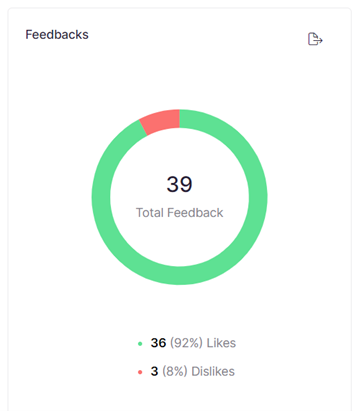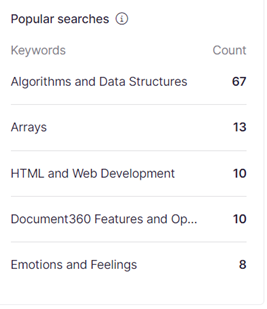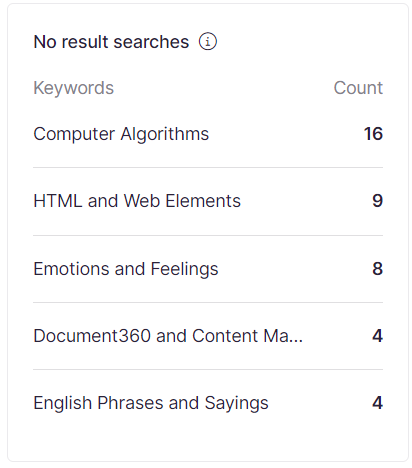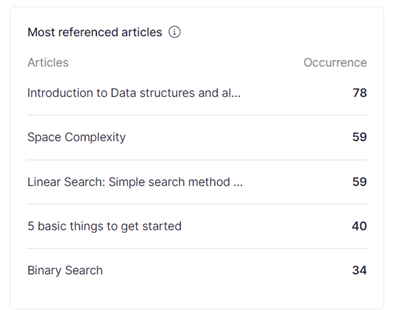The rapid growth of LLM models in the space of AI has significantly shifted the paradigm of leveraging those capabilities across domains. Document360 recognizes this evolution and offers powerful tools to content creators to enhance their productivity while keeping up with technology trends. Eddy – AI assistive search is one of the prime examples and stands out as the key feature harnessing the power of the latest LLM models.
Understanding AI Search Analytics
Eddy – AI Assistive search aids users to retrieve and read the information with precision for the prompt/query raised based on the documentation. The underlying capabilities traverse through content and display contextual information gathered from multiple sources of articles. However, there is a chance that the search will have no or incorrect results.
While readers benefit most from it, there is little to no information available to the contributors to modify the content and prevent the system from generating invalid search results. Hence, search analytics plays a crucial role in understanding user behavior and preferences. This enables technical writers to optimize their content, leading to improved AI search results. This could also involve identifying frequently asked questions that are not adequately addressed or recognizing new topics for content creation.
Key Metrics to Explore in Search Analytics
Eddy Analytics provides a comprehensive overview of user interactions within the system, encompassing various key metrics.
Total Searches
These metrics include the total number of questions asked by the readers, successful searches generating responses, and tracking the no-result searches. This information serves as a measure of user engagement and information needs.

Total Feedback
All successful searches have a mechanism to collect feedback, which is categorized as likes or dislikes. This metric creates awareness for the contributors to identify areas of improvement and update content in relevant articles. Also, the same data points can be leveraged to gauge user satisfaction.

Search Analysis
Moreover, timeline series charts, being visualization elements, facilitate the number of searches performed over a specific period. Users can gain a deeper understanding of usage patterns and seasonal trends, informing strategic decision-making and content planning.

The goal of inference with these numerical data is often to support decision-making, which assists contributors in understanding user engagement with assistive search and its benefits for their readers, ultimately aiding in improving the article content.
Interpreting Trends and Patterns
Identifying trends and patterns in search prompts can be incredibly valuable, as it can assist contributors with content creation and content curation – which may involve updating and associating articles with respective attachments, images, or artifacts.
Most popular searches
We understand this, and our algorithms share the popular topics of searches that have been performed for the month.

No result searches
In addition, the no-result searches displayed bifurcates with the popular topics. However, Eddy wasn’t able to provide appropriate information since the available content was not sufficient to generate a response. Based on these analytics, authors can enhance the existing content that has been published.

Understanding the trends in what users are searching for can provide insights into user behavior, preferences, and needs. This information can guide content creation, product development, and marketing strategies.
Exploring Practical Data Insights
As we understand, Eddy refers to the article content in the documentation, and the details of the articles that were most referenced to generate responses are displayed. This provides comprehensive information for users about the quality of the content and implicitly conveys the details that are most sought after in the respective articles. A classic example of this is the latest software release usually occurs on monthly releases, with a highly anticipated feature, and for understanding, the same Readers often query about it, whereas Eddy references the reference article content and shares information.

Furthermore, exporting data generated by the prompts offers content managers knowledge on the areas of refinement and shares insight into the possibilities of creating new articles for unavailable information.
Conclusion
With these emerging search patterns, contributors can perform changes in their content, accordingly, eliminating the risks of lack of information for the readers and improving the content strategies.
An intuitive knowledge base software to easily add your content and integrate it with any application. Give Document360 a try!
GET STARTED




 –
– 

